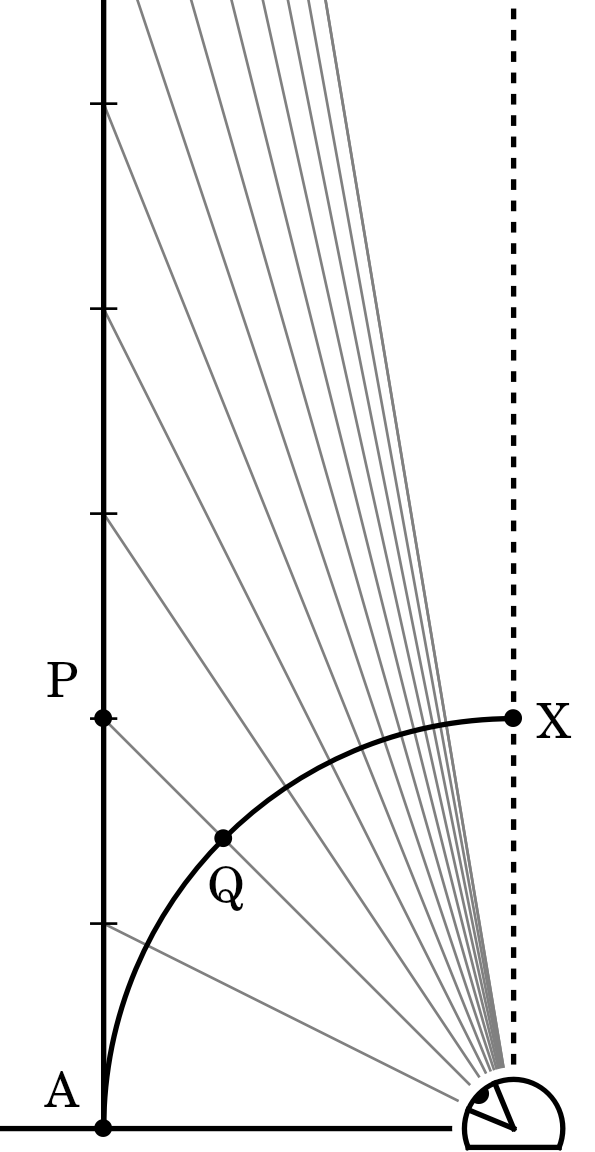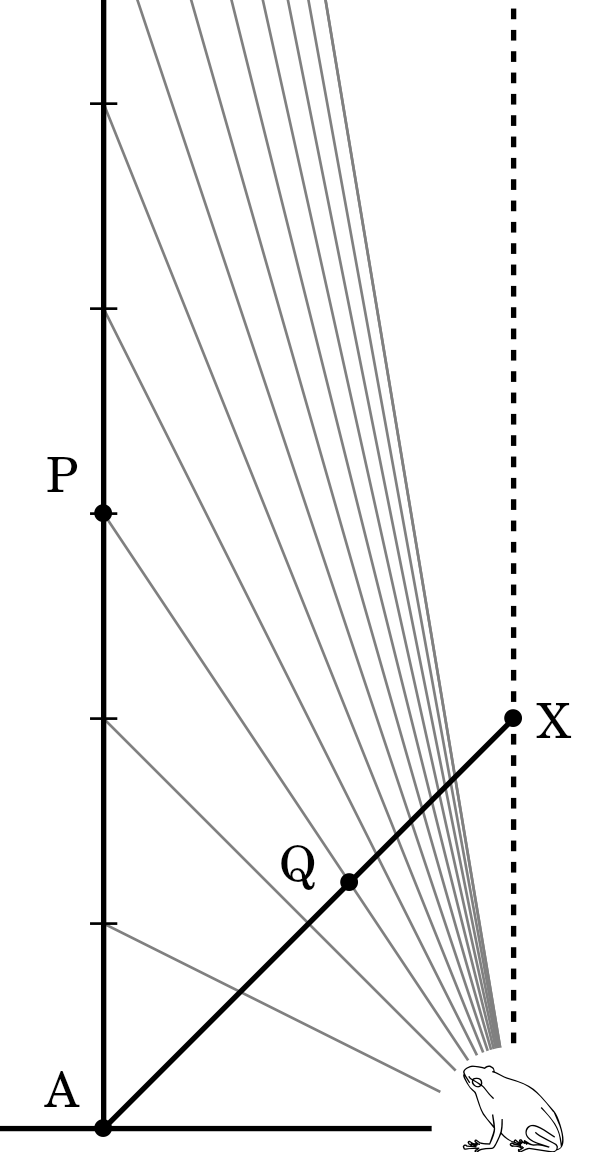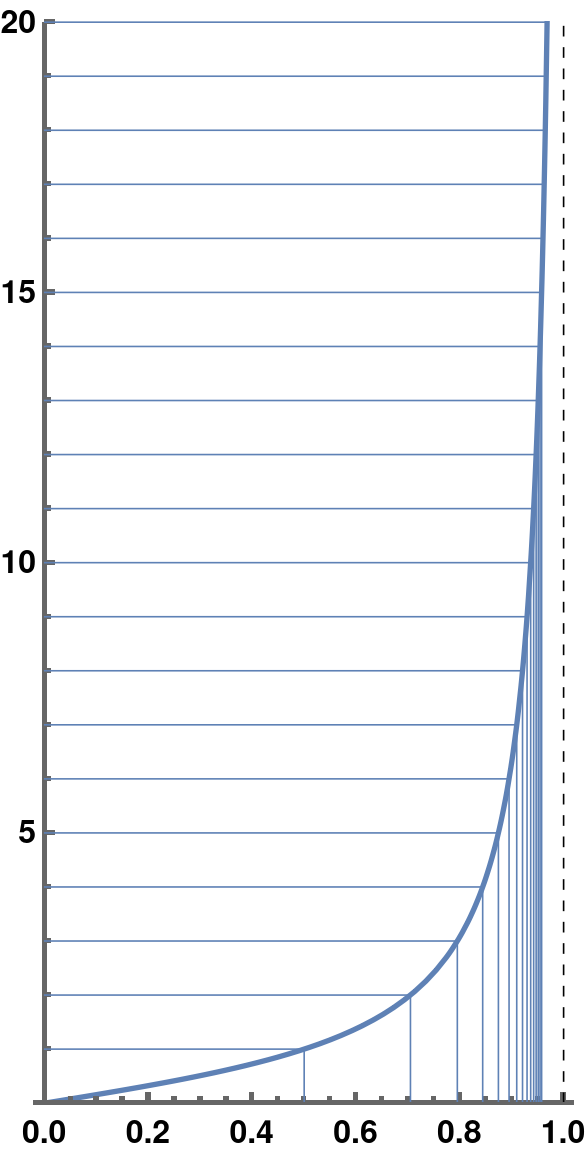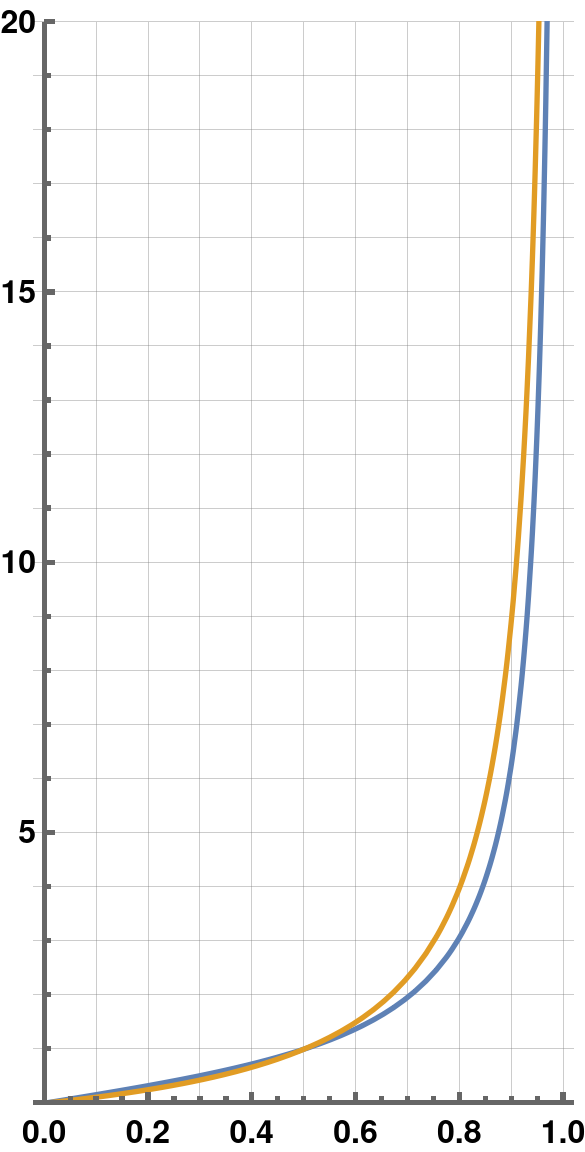One-point perspective
To build from the ground up, imagine a frog looking at an extremely
("infinitely") tall sequoia trees. So tall in fact, that in order to see the very
tip, the frog must look straight up – at the zenith. Because all the
trees extend indefinitely, whichever trunk the frog follows, his gaze ends
up in the same direction. It is as if the tree-lines met in a single point.
This is the first indication of the existence of a special point that
governs the perspective.
The frog's line of sight extends from his eye (the other eye resting closed
for the moment) into the
three-dimensional world he sees, but it becomes a single point in the
two-dimensional perceived image, indicating just the direction of the gaze.
And even though the frog's head is stationary, he can look at various parts
of the image, by minute eye movements, without altering the whole picture.
Most importantly, the trees will still appear to converge to a single
point, regardless of whether the frog is currently looking at it.


Suppose now, that there are evenly spaced, horizontal branches on each of
the trees. The frog knows the branches grow exactly sixty frog-feet apart,
but they seem to be growing closer and closer together, the higher he
looks. This must be so, for the tree is infinite in length, and there are
infinitely many branches which somehow all fit into his field of view. Put
another way, if he painted what he sees, the canvas would have finite width
and height, and he could not fit infinitely many ievenly spaced branches on
it.
Similarly, each branch appears shorter than the one below it. It makes
sense that all directions are shrunk, as things get farther away, and yet
the vertical direction is distinguished, because of the convergence. After
a minute of thought, the frog decides that the tips of the branches form a
line themselves. This line, being vertical, approaches the line of the
trunk, so the lengths of the branches must decrease. It's all caused by
the special point above! he concludes.
There really are two effects at play here:
- The perceived distance between the trees and the length of the
branches both getting shorter as the frog looks higher and higher.
- The perceived distance between consecutive branches getting shorter.
The former involves a convergence, and possibly intersection, of
all the ideal lines corresponding to the trees. That will be the common
perspective point. But the latter is observable already for a single tree, it
must be a one-dimensional effect – there is no convergence of lines
involved, and no intersection point. We shall come back to this point later on.
For now, the frog decides to return home to his pond, and practice with the
one-point perspective.
Two-point perspective
When the frog looks right, he discovers a regularity to how the branches
are arranged. The ideal trees have perfectly straight branches which, like
minature trees lying on their side, all point to the right. And although
they are finite in length, they could be imagined to lie on infinite lines
which again meet in a common point, perhaps far on the horizon. That the
lines should meet at all is again a consequence of the perceived shrinking:
The distances between branches look shorter and shorte, as the frog looks
farther and farther down the line of trees.
Interlude: Distance
We wonder at this point: do the y-lines help us determine how objects
shrink when we look along x-lines? And vice-versa: each tree grows along a
vertical line, determined by the point X, but what determines the width of
each tree-trunk as we go along the horizontal line? Is there some special
spacing along the perspective lines? Perhaps the angles between them?
To answer, the frog has to imagine himself from the side, looking at just
one tree. As noted before this effect is truly one-dimensional, so one line
should be enough. We can depict what he sees in two ways, depending on the
model of his internal image. One is spherical, the other flat.
These are the two simplest versions of how the actual section of equal
distance get projected onto the perceived image, or a canvas. To distill
the essential geometry, the frog has been temporarily moved to Flatland, so
his field of view encompasses only the arc \(\mathrm{AX}\) (or the segment
\(\mathrm{AX}\) in the
second version). Either of the lines \(\mathrm{AX}\) constitute everything the frogg can
see without moving his eyes, and lengths along \(\mathrm{AX}\) correspond directly to
whether an object appears long or short.
And it is not hard to conenct this with the usual two-dimensional field of
view that we experience – just imagine, that we are looking at the
frog from the side, seeing his canvas \(\mathrm{AX}\) edge-on. But the point is that
even in one dimension, the persepctive point X produces progressive
shrinking, even before convergence, because it requires an additional
dimension along which other trees can grow.
How fast exactly do object shrink? Some basic geometry tell us, that in the
first case, the distance along the trunk is just the tangent:
\(\mathrm{AP} = \tan(\angle\mathrm{A𓆏Q})\), or, taking the total length of
the arc \(\mathrm{AX}\) to be 1: \(\mathrm{AP}=\tan\!\left(
\frac{\pi}{2}\mathrm{AQ}\right)\). In the second case the formula can be
obtained without trigonometry, just similarity of triangles gives
\(\mathrm{AP} = \frac{\mathrm{AQ}}{1-\mathrm{AQ}}\),
again assuming that \(\mathrm{AX}\) is of unit length.
Here is what the functions look like.
The vertical axis is the tree with real distances on it – these
are the spacings between branches. The horizontal
axis would, in fact, be the perspective line on the canvas. And the
blue vertical lines show how the branches have to be squeezed. The
second graph just shows the difference between the spherical and flat
version. On a real painting, with details and colours drawing out
attention away from the ideal geometry, this difference will be negligible.
Especially if the object being painted are not composed of straight
lines or artistic liberty is used for emphasis.
Three-point Perspective
Finally!
Conjugate Two-point Perspective
The owl, however, disagrees. When she flies high up by trees, so high that
she can no longer see the ground, the trunks appear to extend indefinitely
both upward and downward. Not only do the lines converge in the zenith
– they do so in the nadir as well. So if the trunks appear thinner
and thinner above and below the owl, that means they are the thickest
directly in front of her...
Interlude: Distortion
What about the fish?
A five-point perspective mix
What about the wolf?
Six-point perspective
The passing from a single converging perspective point X to the pair
XN and
XS corresponds to including both ends of the infinite parallel lines,
however paradoxical it may sound. For every such line, the gaze can follow
it to infinity forwards or backwards – or left or right, upwards or
downwards, as the case may be. There are two distinct directions at which the gaze
can end up, and thus two distinct points of convergence.
In three dimensions, there can be, not surprisingly, three mutually
perpendicular axes. With each axis comes a pair of such convergence
points, so six points in total – exactly like the six faces of a
cube.
How the sets of lines bend and converge can best be seen, when they are
projected onto an imagined sphere around an all-seeing eye. The vertical
lines become the meridians, and likewise for the other directions after
some head tilting.
![]()
In addition to the cubic room, another Platonic solid applies here: points
should more appropriately become corners, not walls, and an octahedron
emerges.





